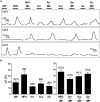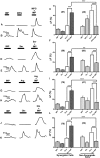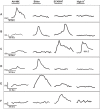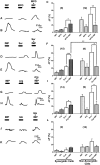L-Amino Acids Elicit Diverse Response Patterns in Taste Sensory Cells: A Role for Multiple Receptors
- PMID: 26110622
- PMCID: PMC4482487
- DOI: 10.1371/journal.pone.0130088
L-Amino Acids Elicit Diverse Response Patterns in Taste Sensory Cells: A Role for Multiple Receptors
Abstract
Umami, the fifth basic taste, is elicited by the L-amino acid, glutamate. A unique characteristic of umami taste is the response potentiation by 5' ribonucleotide monophosphates, which are also capable of eliciting an umami taste. Initial reports using human embryonic kidney (HEK) cells suggested that there is one broadly tuned receptor heterodimer, T1r1+T1r3, which detects L-glutamate and all other L-amino acids. However, there is growing evidence that multiple receptors detect glutamate in the oral cavity. While much is understood about glutamate transduction, the mechanisms for detecting the tastes of other L-amino acids are less well understood. We used calcium imaging of isolated taste sensory cells and taste cell clusters from the circumvallate and foliate papillae of C57BL/6J and T1r3 knockout mice to determine if other receptors might also be involved in detection of L-amino acids. Ratiometric imaging with Fura-2 was used to study calcium responses to monopotassium L-glutamate, L-serine, L-arginine, and L-glutamine, with and without inosine 5' monophosphate (IMP). The results of these experiments showed that the response patterns elicited by L-amino acids varied significantly across taste sensory cells. L-amino acids other than glutamate also elicited synergistic responses in a subset of taste sensory cells. Along with its role in synergism, IMP alone elicited a response in a large number of taste sensory cells. Our data indicate that synergistic and non-synergistic responses to L-amino acids and IMP are mediated by multiple receptors or possibly a receptor complex.
Conflict of interest statement
Figures








Similar articles
-
Metabotropic glutamate receptors are involved in the detection of IMP and L-amino acids by mouse taste sensory cells.Neuroscience. 2016 Mar 1;316:94-108. doi: 10.1016/j.neuroscience.2015.12.008. Epub 2015 Dec 14. Neuroscience. 2016. PMID: 26701297
-
Comparison of L-monosodium glutamate and L-amino acid taste in rats.Neuroscience. 2007 Aug 10;148(1):266-78. doi: 10.1016/j.neuroscience.2007.05.045. Epub 2007 Jul 16. Neuroscience. 2007. PMID: 17629624
-
Dried bonito dashi: taste qualities evaluated using conditioned taste aversion methods in wild-type and T1R1 knockout mice.Chem Senses. 2015 Feb;40(2):125-40. doi: 10.1093/chemse/bju067. Chem Senses. 2015. PMID: 25604941
-
Multiple receptor systems for glutamate detection in the taste organ.Biol Pharm Bull. 2008 Oct;31(10):1833-7. doi: 10.1248/bpb.31.1833. Biol Pharm Bull. 2008. PMID: 18827337 Review.
-
Metabotropic glutamate receptor type 1 in taste tissue.Am J Clin Nutr. 2009 Sep;90(3):743S-746S. doi: 10.3945/ajcn.2009.27462I. Epub 2009 Jul 1. Am J Clin Nutr. 2009. PMID: 19571209 Review.
Cited by
-
Progress and renewal in gustation: new insights into taste bud development.Development. 2015 Nov 1;142(21):3620-9. doi: 10.1242/dev.120394. Development. 2015. PMID: 26534983 Free PMC article. Review.
-
Taste Perception of Sweet, Sour, Salty, Bitter, and Umami and Changes Due to l-Arginine Supplementation, as a Function of Genetic Ability to Taste 6-n-Propylthiouracil.Nutrients. 2017 May 25;9(6):541. doi: 10.3390/nu9060541. Nutrients. 2017. PMID: 28587069 Free PMC article.
-
Does the RAAS play a role in loss of taste and smell during COVID-19 infections?Pharmacogenomics J. 2021 Apr;21(2):109-115. doi: 10.1038/s41397-020-00202-8. Epub 2020 Dec 15. Pharmacogenomics J. 2021. PMID: 33323946 Free PMC article. Review. No abstract available.
-
Genetic effect on free amino acid contents of egg yolk and albumen using five different chicken genotypes under floor rearing system.PLoS One. 2021 Oct 8;16(10):e0258506. doi: 10.1371/journal.pone.0258506. eCollection 2021. PLoS One. 2021. PMID: 34624067 Free PMC article.
-
Umami synergy as the scientific principle behind taste-pairing champagne and oysters.Sci Rep. 2020 Nov 18;10(1):20077. doi: 10.1038/s41598-020-77107-w. Sci Rep. 2020. PMID: 33208820 Free PMC article.
References
-
- Beauchamp GK, Bertino M, Engelman K. Modification of salt taste. Annals of internal medicine. 1983;98(5 Pt 2):763–9. - PubMed
-
- Bertino M, Beauchamp GK, Engelman K. Long-term reduction in dietary sodium alters the taste of salt. The American journal of clinical nutrition. 1982;36(6):1134–44. - PubMed
-
- DeMet E, Stein MK, Tran C, Chicz-DeMet A, Sangdahl C, Nelson J. Caffeine taste test for panic disorder: adenosine receptor supersensitivity. Psychiatry research. 1989;30(3):231–42. - PubMed
-
- Dess NK, Edelheit D. The bitter with the sweet: the taste/stress/temperament nexus. Biological psychology. 1998;48(2):103–19. - PubMed
-
- Fabbi F. Gustatory sense modifications in diabetes. Archiv fur Ohren-, Nasen- und Kehlkopfheilkunde, vereinigt mit Zeitschrift fur Hals-, Nasen- und Ohrenheilkunde. 1954;164(6):543–6. - PubMed
Publication types
MeSH terms
Substances
LinkOut - more resources
Full Text Sources
Other Literature Sources
Medical
Molecular Biology Databases
Miscellaneous

